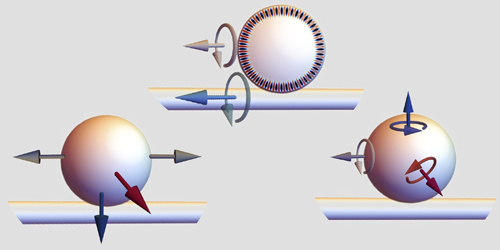A Theoretical Framework for Optical Forces around a Fiber
Evanescent fields produced by light propagating through an optical fiber can interact with small dielectric particles positioned near the fiber. The most obvious interaction is a force that arises from intensity gradients, which can pull particles toward the fiber or push them away from it. But experiments have also detected a weaker set of asymmetric lateral and rotational forces, which are predicted to emerge when the light in the fiber is helically polarized—it carries orbital angular momentum. In a new theoretical study, Jinsheng Lu of Harvard University and colleagues show that for dielectric particles larger than the light’s wavelength, resonant interactions with evanescent fields can induce such asymmetric forces even in the absence of helical light polarization [1]. Furthermore, they find that these forces can be much stronger than those seen for subwavelength particles.
The researchers consider a 2.7-µm-diameter optical fiber adjacent to a 10.6-µm sphere, both submerged in water. In the fiber, they model two counterpropagating light waves with different polarizations. The evanescent fields of these light waves can excite a “whispering-gallery mode” (WGM) in the microsphere, whose precise resonant wavelength differs for each polarization direction. As a result of this polarization-dependent resonance, the two input light waves induce distinct WGMs with different phase shifts. Even when the input light waves are not helically polarized, these phase shifts can impart a “synthetic” helicity to the light mode in the sphere.
From their model, Lu and colleagues derive a comprehensive framework for explaining how resonant interactions with the evanescent field cause the microsphere to rotate, move along the fiber axis, or even orbit around the fiber. They say that the effect could lead to new ways to optically manipulate microscopic objects in medical, sensing, or nanoengineering applications.
–Marric Stephens
Marric Stephens is a Corresponding Editor for Physics Magazine based in Bristol, UK.
References
- J. Lu et al., “Polarization-dependent forces and torques at resonance in a microfiber-microcavity system,” Phys. Rev. Lett. 130, 183601 (2023).




